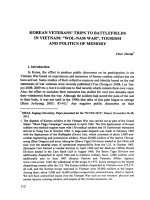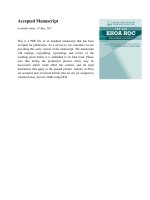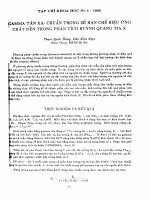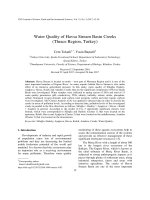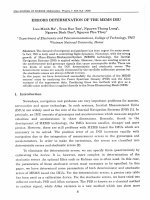DSpace at VNU: Gamma irradiation of cotton fabrics in AgNO3 solution for preparation of antibacterial fabrics
Bạn đang xem bản rút gọn của tài liệu. Xem và tải ngay bản đầy đủ của tài liệu tại đây (1.1 MB, 6 trang )
Carbohydrate Polymers 101 (2014) 1243–1248
Contents lists available at ScienceDirect
Carbohydrate Polymers
journal homepage: www.elsevier.com/locate/carbpol
Gamma irradiation of cotton fabrics in AgNO3 solution for preparation
of antibacterial fabrics
Truong Thi Hanh a,∗ , Dang Van Phu a , Nguyen Thi Thu a , Le Anh Quoc a ,
Do Nu Bich Duyen b , Nguyen Quoc Hien a
a
b
Research and Development Center for Radiation Technology, VINATOM 202A, Street 11, Linh Xuan Ward, Thu Duc District, Ho Chi Minh City, Vietnam
Ho Chi Minh City University of Technology, 268 Ly Thuong Kiet, Ward 14, District 10, Ho Chi Minh City, Vietnam
a r t i c l e
i n f o
Article history:
Received 21 March 2013
Received in revised form 17 October 2013
Accepted 20 October 2013
Available online 26 October 2013
Keywords:
Silver nanoparticles
Cotton fabrics
Chitosan
Antibacterial
␥- irradiation
a b s t r a c t
Silver nanoparticles (AgNPs) with diameter about 12 nm were immobilized on the surface of cotton
fabrics by ␥-irradiation of fabrics in the AgNO3 chitosan solution. Effects of absorbed dose, concentration
of AgNO3 solution on immobilization of the AgNPs on fabrics were investigated. The optimal dose was
selected to be 13.8 kGy and the suitable concentration of AgNO3 was 1.5 mM in 1% chitosan solution. The
content of AgNPs on fabrics was of 1696 ± 80 mg/kg for these conditions. The presence of AgNPs on fabrics
was confirmed from scanning electron microscopy (SEM) images and X ray diffraction (XRD) patterns.
The antibacterial activity of AgNPs/cotton fabrics after 40 washings against Staphylococcus aureus and
Escherichia coli was found to be 99.99%. In addition, the AgNPs fabrics were innoxious to the skin (k = 0)
after 1, 5, 10, 20, 30 and 40 washings by skin-irritation testing to animal (rabbit).
© 2013 Elsevier Ltd. All rights reserved.
1. Introduction
The synthesis and functionalization of silver nanoparticles
(AgNPs) have been extensively investigated in past decades due to
their remarkable properties and potential applications. A number
of reports are available on the synthesis of metal nanoparticles in
solution by different methods (Hannan & Subbalaxmi, 2011; Sáez
& Mason, 2009; Szczepanowics, Stefanska, Socha, & Warszynski,
2010). Bolge, Dhole, and Bhoraskar (2006) described the synthesis of dispersed nanoparticulate silver using gamma-irradiation.
Chen, Song, Liu, and Fang (2007) also synthesized silver nanoparticles by ␥-ray irradiation in acetic aqueous solution containing
chitosan. The broad-spectrum of antimicrobial properties of AgNPs
encourage its use in biomedicine, water and air purification, food
production, cosmetics, numerous household products (Li et al.,
2008; Mritunjai, Shinjini, Prasad, & Gambhir, 2008). Because of their
effective antimicrobial properties and low toxicity toward mammalian cells, AgNPs have become one of the most commonly used
nanomaterials in consumer products (Choi et al., 2008). Kokura
et al. (2010) proved that silver nanoparticles were able to be used
for preservation of cosmetics against mixed bacteria and mixed
fungi. AgNPs can be immobilized on the fibers, bringing new properties to the final textile product, especially for antibacterial effect.
The antibacterial fabrics can be used to make bandage, gauze, bed
sheets, surgical clothes. . . (Dubas, Kimlangdudsana, & Potiyaraj,
2006; Gupta, Bajpai, & Bajpai, 2008). The AgNPs interact with the
bacterial membrane and are able to penetrate inside the cell. The
mechanisms of interaction involved AgNPs attached to bacterial
cell membranes increase permeability and disturb respiration. The
AgNPs may catalyze reactions with oxygen leading to reactive
oxygen species (ROS) production which can cause DNA damage,
protein and cell membrane breakdown. The catalytic silver can
destroy bacteria’s disulfide bonds to counteract the synthesis of
bacterial cell. AgNPs are oxidized generating silver ions that can
disrupt ATP production (adenosine triphosphate) to inhibit the
adsorption of phosphate of protein (Jone & Hoek, 2010).
The AgNPs in the environment as wastewater treatment plant
effluent were associated with reduced sulfur from organic thiols
groups and inorganic sulfides to Ag2 S. Sulfide exhibits a much lower
toxicity than other form of Ag (Kaegi et al., 2011).
In this study, AgNPs immobilized on cotton fabrics by in situ
synthesis. Silver ions were reduced to silver atoms by ␥-irradiation
and simultaneously immobilized on the fabrics. The durability of
AgNPs linked with cotton fabrics and antibacterial effects as well as
skin irritation test were also investigated after repeated washings.
2. Experimental
2.1. Materials
∗ Corresponding author. Tel.: +84 8 62829159; fax: +84 8 38975921.
E-mail address: (T.T. Hanh).
0144-8617/$ – see front matter © 2013 Elsevier Ltd. All rights reserved.
/>
Cotton fabrics (100%) were provided by VICOTEX Company
(Vietnam) with weighing 120 g/m2 . They were washed to remove
1244
T.T. Hanh et al. / Carbohydrate Polymers 101 (2014) 1243–1248
glue then dried and cut into equal-sized square pieces measuring
0.5 m × 0.5 m, before using. Shrimp shell chitin was supplied by a
factory in Vung Tau province, Vietnam. Chitin was treated in 3%
sodium hydroxide (w/v) at 100 ◦ C for 3 h for deproteinization and
in 3% hydrochloric acid (v/v) for decalcification. Chitosan with a
degree of deacetylation (DD%) about 80% was prepared by deacetylation of chitin in 50% sodium hydroxide at 100 ◦ C for 1 h. This value
was determined based on FT-IR spectra according to the following
equation (Brugnerotto et al., 2001):
The mechanical properties were determined using a Strograph
V10-C (Toyoseiki Co., Japan) testing instrument at a constant
crosshead speed of 50 mm/min. Five specimens with a dumbbells
shape were prepared according to ASTM D 1882-L and were used
for the measurement.
A1320
= 0.3822 + 0.0313(100 − DD%)
A1420
Antibacterial properties of resultant fabrics were verified
according to AATCC Test Method 100–2004 against Staphylococcus aureus No. 6538, a Gram-positive organism and Escherichia
coli No. 10229, a Gram-negative organism (AATCC Test method:
100–2004). The inoculum concentration of bacteria in a germ
containing nutrient solution was 1 × 107 to 2 × 107 CFU/ml. Test
specimens were cut in 4.8 ± 0.1 cm diameters and absorbed 1 ml
of inoculum in sterile Petri plates. Then, specimens were placed in
the jar contained 100 ml neutralizing solution. Jars were shaken
vigorously for 1 min, serial dilutions were made. From each of
three suitable dilutions, 0.1 ml liquid was drawn and transferred
to nutrient agar, then incubated all plates for 48 h at 37 ◦ C. Percent
reduction of bacteria was calculated from the number of bacteria recovered in the jar immediately after inoculation and the jar
incubated over desired period.
Skin irritation test was carried out by Institute of Drug Testing following ISO 10993-10 (2002). This test was carried out on
grown and healthy rabbits weighing at least 2 kg. The rabbits
using for the irritation test were reared at 25 ◦ C, with humidity
of 30–70%. The AgNPs/cotton fabrics were applied to shaved skin
about 10 cm × 15 cm in the back of rabbit. The skin situation of the
rabbits was observed after 12, 24, 48 and 72 h.
(1)
where A1320 , A1420 are absorbance of chitosan at 1320 and
1420 cm−1 , respectively.
The Mw of chitosan (7.63 × 104 ) was measured by an Agilent
1100 gel permeation chromatography (GPC; Agilent Technologies, USA) with detector RI G1362A and the column ultrahydrogel
model 250 from Waters (USA). The standards for calibration of the
columns were pullulan (Mw 780–380 × 103 ). All other chemicals,
including silver nitrate (AgNO3 ), (S) – lactic acid (90%), sodium
hydroxide (NaOH) were of reagent grade. Distiled water was used
in all experiments.
2.2. Preparation of AgNPs/cotton fabrics by -irradiation of
cotton fabrics in AgNO3 solution
Cotton fabrics about 60 g after washing were irradiated in 500 ml
of 0.5 to 5.0 mM AgNO3 solution using the stabilizer of 1.0% chitosan
in the dose range from 5 to 20 kGy. The gamma-irradiation dose was
determined by using the ethanol-chlorobenzene (ECB) dosimetry
system from mean value of absorbed doses of three dosimeters at
30 ◦ C. The AgNPs/cotton fabrics were washed according to a mod˙
ified PN-EN ISO 105-C06: 2010 (AS1) (Marek Koz Elzbieta
et al.,
2013) in order to assess resistance to the washing process. The
maximum number of washing was 40 cycles. An approximately
3 g weight sample was placed in 150 cm3 of washing liquor and
was washed at 40 ◦ C for 30 min (one cycle). The concentration of
the active surface agent was equal to 1 g/dm3 . Afterwards, samples
were rinsed with water and dried at 40 ◦ C for 40 min. A similar
procedure was applied for 40 repeated washes. The content of
AgNPs was evaluated by inductively coupled plasma atomic emission spectroscopy (ICP-AES), model Optima 5300DV (Perkin Elmer)
after 1, 5, 10, 20, 30 and 40 washings.
All collected data were expressed as mean ± SE – standard error,
in this study. The differences between sample values were assessed
using two-tailed unpaired Student’s t-tests. The standard error
should be <±5% at a 95% confidence level, number of samples that
were analyzed per condition to be three (N = 3).
2.3. Characterization of the AgNPs/cotton fabrics
The presence of AgNPs on fabrics was confirmed by SEM image,
using a JSM-6480LV scanning electron microscopy was operated
at 10 kV and used at 1,300 and 5,500 magnifications. X ray diffraction patterns were measured on a Shimadzu 5A diffractometer with
CuK␣ radiation (35 kV and 25 mA), scanning at a speed of 0.5◦ /min
from 5–80◦ (2Â). The crystalline silver nanoparticle has been estimated by using Debye–Scherrer formula:
D=K·
ˇ cos Â
(2)
˚ ˇ is the full
where K = 0.89, is the wave length of X-ray (1.5405 A),
width at half maximum (FWHM), Â is the diffraction angle (Bragg)
and D is the particle diameter size (Baker, Pradhan, Pakstis, Pochan,
& Shah, 2005)
2.4. Antibacterial efficacy and skin irritation test of the
AgNPs/cotton fabrics
3. Results and discussion
3.1. Preparation of AgNPs/cotton fabrics
The AgNPs/cotton fabrics were prepared by ␥-irradiation of cotton fabrics in silver nitrate solution. The influential factors such
as the initial Ag+ concentration and absorbed dose on the immobilization of AgNPs onto fabrics were investigated by ICP-AES. During
␥-irradiation of cotton fabrics in the AgNO3 solution, the hydrated
electron (eaq − ) and radical of H• that were generated by water
radiolysis can reduce Ag+ to Ag as shown in Eqs. (3)–(5) (Long, Wu,
& Chen, 2007). Continuous reduction of the Ag+ solution causes
the aggregation of clusters into AgNPs. In chitosan solution, the
• OH groups can react with chitosan to abstract hydrogen and form
macromolecule free radicals as Eq. (6). These radicals can reduce the
cluster of Ag+ ions forming the cluster of Ag atoms on fabric surface (Eq. (7)). The binding of silver clusters by chitosan is achieved
through the Ag O bond (Chen, Wu, & Zeng, 2005). The reactions
can be proposed as follows:
H2 O (␥-rays) → • OH + e− aq + • H + H2 O2 + H2 + . . .
(3)
Ag+ + e− aq → Ag0
(4)
Ag+ + H• → Ag0 + H+
(5)
[C6 H11 O4 N]n (chitosan) + • OH
→ [C6 H11 O4 N]n−1 [C6 H10 O4 N]• + H2 O
(6)
Ag+ + [C6 H11 O4 N]n−1 [C6 H10 O4 N]•
→ Ag0 -[C6 H11 O4 N]n−1 [C6 H9 O4 N] + H+
(7)
T.T. Hanh et al. / Carbohydrate Polymers 101 (2014) 1243–1248
5000
AgNPs content (mg/kg)
2000
AgNPs content (mg/kg)
1245
1600
1200
800
4000
3000
2000
1000
400
0
0
0
0
5
10
15
20
1
2
3
4
5
6
AgNO3 Conc. (mM)
Dose (kGy)
Fig. 2. Effect of AgNO3 concentration on the content of AgNPs on the cotton fabrics.
Fig. 1. Relationship between the content of AgNPs on the cotton fabrics and irradiation dose.
nAg0 → Ag2 → . . . Agn
(8)
The absorbed dose plays an important role in formation and
growth of AgNPs by reduction of Ag+ to Ag0 atom by ␥-irradiation.
At a low dose, nanoparticles have not appeared yet, while nanoparticles will be formed at a higher dose. In this study, the preparation
of the AgNPs/cotton fabrics by in situ synthesis in which Ag+ ions
were reduced to Ag atoms and simultaneously deposited on cotton
fabrics. The interaction between fibers and metallic AgNPs which
were stabilized by chitosan results from formation of chemical
bond between silver and alcoholic groups of cotton and physical
adsorption of AgNPs on the fabric surface (Perelshtein, Applerot, &
Perkas, 2008). Fig. 1 clearly indicates that the content of AgNPs on
the cotton fabrics has changed insignificantly in the range of low
doses from 4 to 10 kGy, but increased at higher doses. A maximal
value of the AgNPs content on fabrics was found to be 1696 mg/kg
for the cotton fabrics in 1.5 mM AgNO3 solution irradiated at the
dose of 13.8 ± 0.6 kGy.
The effect of Ag+ concentration on the content of the AgNPs
when irradiation of the cotton fabrics in AgNO3 solution was also
investigated. In Fig. 2, the content of AgNPs on the fabrics increased
as using the initial Ag+ concentrations from 0.5 to 5 mM at the
dose of 13.8 kGy. In order to control the release of silver nanoparticles into environment but keeping the antibacterial purpose after
washings, the cotton fabrics which were immobilized with AgNPs
at the content of 1696 ± 80 mg/kg corresponding to Ag+ salt concentration of 1.5 mM was selected for further investigation.
Fig. 3. SEM images of: original cotton fabrics (a) ×1300 and (c) ×5500; AgNPs cotton fabrics (b) ×1300 and (d) ×5500.
1246
T.T. Hanh et al. / Carbohydrate Polymers 101 (2014) 1243–1248
Table 1
The tensile strength and elongation at break of cotton fibers against irradiation
doses.
Dose (kGy)
Tensile strength (kf/mm2 )
0
4.3 ± 0.2
7.5 ± 0.4
10.6 ± 0.5
13.8 ± 0.6
17.8 ± 0.8
20.3 ± 0.9
31.0
30.5
29.5
27.0
26.5
21.3
20.0
±
±
±
±
±
±
±
1.6
1.5
1.5
1.3
1.3
1.1
1.0
Elongation (%)
50
46
44
38
36
27
22
±
±
±
±
±
±
±
2.3
2.0
2.0
1.5
1.5
1.3
1.0
insignificantly. Therefore, the dose of 13.8 kGy is optimal for conversion of the 1.5 mM AgNO3 to AgNPs in 1% chitosan solution at
30 ◦ C.
Mechanical properties of cotton fabrics were determined in
the dose range from 0 to 20 kGy. The results showed that tensile strength ( ) and elongation at break (ε) of cotton fabrics
slightly lower at the doses below 13.8 kGy in comparison with
non-irradiated cotton fabrics (Table 1). However, these values were
much lower than at the higher doses, so that the irradiation dose
was selected to be 13.8 kGy for irradiation of cotton fabrics.
The XRD patterns in Fig. 5a shows peaks at 12◦ and 21◦ , which
can be attributed to the crystalline structure of cellulose. Four
peaks at 38.25◦ , 43.28◦ , 62.46◦ and 76.32◦ in Fig. 5b assigned to
diffractions from the (1 1 1), (2 0 0), (2 2 0) and (3 1 1) planes of facecentered cubic silver, respectively. This result is in agreement with
reports from other authors who used polysaccharides for stabilizing AgNPs (Phu et al., 2010; Staszewski, Kopyto, Becker Wrona,
Dworak, & Kwarcinski, 2008). The full width at half-maximum of
diffraction peaks (1 1 1) in Fig. 6 is employed to determine the
average crystalline size using Debye–Scherrer as formula (2). The
crystalline size of AgNPs was calculated to be about 12 nm.
3.3. Antibacterial effect and skin irritation test
Fig. 4. UV–vis spectra of colloidal AgNPs from 1.5 mM AgNO3 solution corresponding to irradiation doses of: (a) 4.3 kGy, (b) 7.5 kGy, (c) 10.6 kGy, (d) 13.8 kGy, (e)
17.0 kGy, and (f) 20.3 kGy.
3.2. Characterization of AgNPs/cotton fabrics
The presence of silver nanoparticles onto fabrics can be seen
by SEM images (Fig. 3). The images in Fig. 3a and c show the
smooth structure of the original cotton fabrics before coating with
silver nanoparticles. After gamma-irradiation of cotton fabrics in
AgNO3 solution, the nanoparticles that were dispersed on the surface of the AgNPs/fabrics demonstrated the immobilization of silver
nanoparticles on the fabrics (Fig. 3b). The homogeneous deposition
is observed in a higher magnification image (Fig. 3d). UV–vis spectra were recorded for the colloidal AgNPs from 1.5 mM AgNO3 in
1.0% chitosan solution irradiated by gamma-irradiation with cotton fabrics, in the dose range from 4 to 20 kGy (Fig. 4). The chitosan
concentration was maintained at 1% solution as this provided sufficient chitosan for stabilization of the AgNPs and also allowed for an
acceptable solution viscosity at 30 ◦ C. The UV–vis absorbance spectra of AgNPs depict peak maxima in the range from 416–420 nm
with respective increase in optical density (OD) in gamma dose
from 4 to 13.8 kGy. These results demonstrate a proportional yield
increase of AgNPs with gamma-irradiation dose below 13.8 kGy.
Above 13.8 kGy (17.0 and 20.3 kGy), the optical density changed
The durability of antibacterial substance linked with fabrics is
also an important factor for using. The AgNPs may be immobilized
on fabrics by the bonds of the atomic silver with alcoholic groups
in cellulose structure and chitosan capped AgNPs. According to the
result in Table 2, the AgNPs content on fabrics decreased after the
first washing cycle but changed insignificantly for next washings.
The signs of Ag/CF0 , Ag/CF1 , Ag/CF5 , Ag/CF10 , Ag/CF20 , Ag/CF30 and
Ag/CF40 were the abbreviations of the AgNPs/cotton fabrics before
washing and washing 1, 5, 10, 20, 30 and 40 cycles, respectively.
The layer-by-layer links of the stabilizer molecules coating outside
were formed from electrostatics force, so that they were broken
easily by physical impact or detergent. However, the bonds from
the reactive center of cellulose to AgNPs capping by chitosan may
be durable.
Results in Table 2 also demonstrated that antibacterial activity
was influenced by the content of AgNPs on the fabrics. After 40
washings, an amount of AgNPs was remained on the fabrics of about
858 mg/kg, which inhibited the growth of S. aureus and E. coli to
be 99.95 and 99.98%, respectively. Gupta et al. (2008) also reported
that the AgNPs content is a key factor in controlling the antibacterial
activity. In addition, the AgNPs diameter is also an important role
for antibacterial effect. Lee and Jeong (2005) proved that the AgNPs
size about 2–3 nm has a better antibacterial effect than 30 nm one.
In this study, the AgNPs diameter about 12 nm was also effective
for antibacterial activity.
Testing skin-irritation was carried out for the fabric samples, which were synthesized in situ by ␥-irradiation of fabrics
in the 1.5 mM AgNO3 solution at the dose of 13.8 kGy. The
fabrics imbedded AgNPs were washed from 1, 5, 10, 20,
Table 2
Bacterial reduction of AgNPs cotton fabrics and numerical grades for testing skin irritation on the rabbit skin.
Samples
Washings (times)
AgNPs content on the fabrics (mg/kg)
Ag/CF0
Ag/CF1
Ag/CF5
Ag/CF10
Ag/CF20
Ag/CF30
Ag/CF40
0
1
5
10
20
30
40
1696
1034
1024
910
880
860
858
±
±
±
±
±
±
±
80
50
45
45
40
40
40
Bacterial reduction (%)
Numerical grades
S. aureus
E. coli
Erythema
Edema
100
99.94
99.99
99.94
99.99
99.99
99.95
100
100
100
100
100
100
99.98
0
0
0
0
0
0
0
0
0
0
0
0
0
0
Remark
Skin-innoxious (k = 0)
Skin-innoxious (k = 0)
Skin-innoxious (k = 0)
Skin-innoxious (k = 0)
Skin-innoxious (k = 0)
Skin-innoxious (k = 0)
Skin-innoxious (k = 0)
T.T. Hanh et al. / Carbohydrate Polymers 101 (2014) 1243–1248
1247
Fig. 5. XRD patterns of: (a) The cotton fabrics, and (b) AgNPs cotton fabrics.
Fig. 6. Diffraction angle and the value FWHM at 2Â = 38.25o .
30 and 40 cycles then were applied on the rabbit skin.
The noxiousness on skin was determined from observing
the skin situation after contact times for 12, 24, 48 and
72 h at 25 ◦ C. The erythema and edema on the rabbit skin were
recorded at the numerical grades to be 0 during coating AgNPs
fabrics. These results confirmed that AgNPs/cotton fabrics are
innoxious to skin with coefficient of k = 0 (Table 2). Lee and Jeong
(2005) also reported that the AgNPs of 2–3 nm in diameter have the
numerical grading to be 0 for erythema and edema. They included
AgNPs with 2–3 nm size was skin-innoxious.
4. Conclusions
The silver ions were reduced effectively by gamma irradiation
and immobilized on the cotton fabrics by in situ synthesis. The
AgNPs content deposited on the fabrics was of 1696 mg/kg, when
the fabric sample was irradiated in 1.5 mM AgNO3 and 1.0% chitosan solution at the dose of 13.8 kGy at 30 ◦ C. The AgNPs were
confirmed by UV–vis spectra and SEM images. The average diameter of AgNPs was determined by XRD pattern to be about 12 nm.
The presence of AgNPs on the fabrics was depicted by SEM images.
1248
T.T. Hanh et al. / Carbohydrate Polymers 101 (2014) 1243–1248
Antibacterial efficacy of the AgNPs fabrics after washing 1, 5, 10,
20, 30 and 40 cycles was about 99.99% for S. aureus and E. coli. The
AgNPs/cotton fabrics washing from 1 to 40 cycles were innoxious
to skin (k = 0). These results demonstrate that gamma irradiation
of cotton fabrics in the presence of aqueous solution of AgNO3 and
chitosan is a promising approach for preparation of stable, safe and
efficacious antibacterial fabrics.
References
Baker, C., Pradhan, A., Pakstis, L., Pochan, D. J., & Shah, S. I. (2005). Synthesis and
antibacterial properties of silver nanoparticles. Journal of Nanoscience Nanotechnology, 5(2), 244–249.
Bolge, K. A., Dhole, S. D., & Bhoraskar, V. N. (2006). Silver nanoparticles: synthesis
and size control by electron – irradiation. Nanotechnology, 17, 3204–3208.
Brugnerotto, J., Lizardi, J., Goycoolea, F. M., Arguelles-Monal, W., Desbrieres, J., &
Rinaudo, M. (2001). An infrared investigation in relation with chitin and chitosan
characterization. Polymer, 42, 3569–3580.
Chen, P., Song, L., Liu, Y., & Fang, Y.-e. (2007). Synthesis of silver nanoparticles by
␥-ray irradiation in acetic water solution containing chitosan. Radiation Physics
and Chemistry, 76(7), 1165–1168.
Chen, S., Wu, G., & Zeng, H. (2005). Preparation of high antimicrobial activity thiourea
chitosan-Ag+ complex. Carbohydrate Polymers, 1, 33–38.
Choi, O., Deng, K. K., Kim, N. J., Ross, L., Surampalli, R. Y., & Hu, Z. (2008). The
inhibitory effects of silver nanoparticles, silver ions, and silver chloride colloids
on microbial growth. Water Research, 42(12), 3066–3074.
Dubas, S. T., Kimlangdudsana, P., & Potiyaraj, P. (2006). Layer-by-layer
deposition of antimicrobial silver nanoparticles on textile fibers. Colloids and Surfaces A: Physicochemical and Engineering Aspects, 289(1–3),
105–109.
Gupta, P., Bajpai, M., & Bajpai, S. K. (2008). Investigation of antibacterial properties
of silver nanoparticle-loaded poly (acrylamide-co-itaconic acid)-grafted cotton
fabric. Journal of Cotton Science, 12, 280–286.
Hannan, N., & Subbalaxmi, S. (2011). Green synthesis of silver nanoparticles using
Bacillus subtillus IA751 and its antibacterial activity. Journal of Nanoscience Nanotechnology, 1(2), 87–94.
ISO 10993-10. (2002). Biological evaluation of medical devices, part 10: Test for
irritation and delayed-type hypersensitivity.
Jone, C. M., & Hoek, E. M. V. (2010). A review of the antibacterial effects of silver nanomaterials and potential implications for human health and the environment.
Journal of Nanoparticle Research, 12, 1531–1551.
Kaegi, R., Voegelin, A., Sinnet, B., Zuleeg, S., Hagendorfer, H., Burkhardt, M., et al.
(2011). Behavior of metallic silver nanoparticles in a pilot wastewater treatment
plant. Environmental Science & Technology, 45, 3902–3908.
Kokura, S., Handa, O., Takagu, T., Ishikawa, T., Naito, Y., & Yoshikawa, T. (2010).
Silver nanoparticles as a safe preservative for use in cosmetics. Nanomedicine:
Nanotechnology Biology and Medicine, 6, 570–574.
Lee, H. J., & Jeong, S. H. (2005). Bacteriostasis and skin innoxiousness of nanosize
silver colloids on textile fabrics. Textile Research Journal, 75(7), 551–556.
Li, Q., Mahendra, S., Lyon, D. Y., Brunet, L., Liga, M. V., Li, D., et al. (2008). Antimicrobial nanomaterials for water disinfection and microbial control: Potential
applications and implications. Water Research, 42(18), 4591–4602.
Long, D., Wu, G., & Chen, S. (2007). Preparation of oligochitosan stabilized silver nanoparticles by gamma irradiation. Radiation Physics and Chemistry, 76(7),
1126–1131.
˙
Marek Koz Elzbieta,
S., Marek Koł Justyna, K., Agnieszka, A., Waldemar, M., Aleksandra, P., Małgorzata, S., et al. (2013). Facile and durable antimicrobial finishing
of cotton textiles using a silver salt and UV light. Carbohydrate Polymers, 91,
115–127.
Mritunjai, S., Shinjini, S., Prasad, S., & Gambhir, I. S. (2008). Nanotechnology in
medicine and antibacterial effect of silver nanoparticles. Digest Journal of Nanomaterials and Biostructures, 3(3), 115–122.
Perelshtein, I., Applerot, G., & Perkas, N. (2008). Sonochemical coating of silver
nanoparticles on textile fabrics and their antibacterial activity. Nanotechnology,
19.
Phu, D. V., Lang, V. T. K., Lan, N. T. K., Duy, N. N., Chau, N. D., Du, B. D., et al. (2010).
Synthesis and antimicrobial effects of colloidal silver nanoparticles in chitosan
by ␥-irradiation. Journal of Experimental Nanoscience, 5(2), 169–179.
Sáez, V., & Mason, T. J. (2009). Sonoelectrochemical synthesis of nanoparticles.
Molecules, 14(10), 4284–4299.
Staszewski, S., Kopyto, D., Becker Wrona, A., Dworak, J., & Kwarcinski, M. (2008). The
X-ray activated reduction of silver solutions as a method for nanoparticle manufacturing. Journal of Achievements in Materials and Manufacturing Engineering,
28(1), 23–26.
Szczepanowics, K., Stefanska, J., Socha, R. P., & Warszynski, P. (2010). Preparation
of silver nanoparticles via chemical reduction and their antimicrobial activity.
Physicochemical Problems of Mineral Processing, 45, 85–98.

